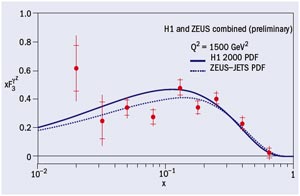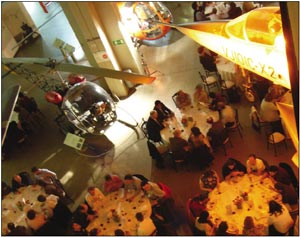A report from the latest workshop on deep-inelastic scattering.
Exceptionally beautiful weather, Munich’s Holiday Inn hotel and the Gasteig, a modern cultural centre, combined to provide a pleasant and stimulating atmosphere for DIS 2007, the 15th International Workshop on Deep-Inelastic Scattering (DIS) and Related Subjects. Held on 16–20 April, the workshop united more than 300 physicists from around the world, including an encouraging number of students. The programme contained reviews of progress in DIS and QCD, as well as presentations of the latest results from HERA, the Tevatron, Jefferson Lab, RHIC and fixed-target experiments. It also covered related theoretical topics and future experimental opportunities.
With two full days of plenary sessions and six streams of parallel sessions on the other three days, the meeting followed the traditional style of DIS workshops. The parallel sessions covered structure functions and low-x physics, electroweak measurements and physics beyond the Standard Model, heavy flavours, hadronic final states, diffraction and spin physics. A special session that looked to the future of DIS was particularly topical in view of the shutdown at DESY of HERA, the world’s only electron–proton collider, at the end of June.
Yuri Dokshitzer, of the University of Paris VI and VII, opened the scientific programme with a review of recent developments in perturbative QCD (pQCD). He explained his motto “1-loop drill, 2-loop thrill, 3-loop chill” and expressed the hope that higher-order corrections can be calculated with the help of N = 4 super-Yang–Mills quantum field theory.
Latest results

Appetizing glimpses of the many new results from the two collider experiments at HERA featured in talks by Christinel Diaconu from the Centre for Particle Physics in Marseille, and by Massimo Corradi of INFN Bologna, for the H1 and ZEUS experiments, respectively. Both experiments have accumulated a total of 0.5 fb–1 at a proton beam energy of 920 GeV, and analyses of the entire data sample are in full swing. The first H1 and ZEUS combined analysis of xF3 was a clear highlight of the conference (figure 1). This is the structure function that is dominated by photon–Z interference and is sensitive to the valence quarks at low Bjorken-x.
Further highlighted results included new data on neutral-current and charged-current inclusive scattering, jets and heavy-flavour production. These data will serve as input for the next generation of more precise fits for parton distribution functions (PDFs) for the proton – essential for studying physics at the LHC at CERN.
Since mid-March the proton beam energy at HERA has been lowered to 460 GeV to enable, in conjunction with the high-energy data at 920 GeV, a model-free determination of the longitudinal structure function FL. This measurement is essential for a direct extraction of the gluon distribution within the proton and as a consistency check of DIS theory. Beyond the Standard Model, H1 continues to see, with the full statistics at high energy, the production of isolated leptons at a level of 3 σ above the expectation. In contrast, ZEUS sees no deviation from the Standard Model.
With the Tevatron proton–antiproton collider at Fermilab performing well, Giorgio Chiarelli of INFN Pisa was able to show a sample of beautiful new results from the CDF and DØ experiments. For this conference, he presented data corresponding to up to
2 fb–1, covering neutral B-meson oscillations, electroweak physics, jets, searches and results on the production of the top quark, with a new world average for its mass of 170.9 ± 1.8 GeV/c2. This new (low) value is interesting since, together with the mass of the W particle, it favours the minimal supersymmetric model.
William Zajc from Columbia University addressed current understanding of particle production in heavy-ion collisions, as studied at RHIC at Brookhaven National Laboratory (BNL). He highlighted several interesting experimental observations, such as “away-side” jet suppression, that cannot be described within current models, but which May be interpreted as a signal for the production of a nearly perfect, highly viscous quark–gluon fluid.

Image credit: Daniel Kollar/MPI Munich.
Turning to spin physics, Jörg Pretz from the University of Bonn gave an overview with emphasis on the nucleon spin puzzle. He presented recent data on helicity distributions for quarks (Δq) and gluons (ΔG), from the HERMES experiment at DESY and COMPASS at CERN, respectively, as well as direct measurements of ΔG from RHIC. He also showed the first combined results on transversity using data from both HERMES and COMPASS as well as from the BELLE experiment at KEK. In a related overview of the rich programme at Jefferson Lab, Zein-Eddine Mezani of Temple University in Philadelphia covered measurements of unpolarized and polarized structure functions and transversity, as well as deeply virtual Compton scattering and generalized parton distributions.
Theoretical input
Andreas Vogt of Liverpool University spoke about progress and challenges in determining and understanding the PDFs of the proton in next-to-leading order (NLO) and next-to-NLO. An important improvement in the extraction of PDFs, implemented by the Coordinated Theoretical–Experimental Project on QCD (CTEQ), is the inclusion of the effects of charm-mass suppression in DIS, which results in an increase in the PDFs for the u and d quark. A dramatic consequence is an increase by about 8% of the W/Z cross-sections expected at the LHC. Rates of W/Z events are foreseen to serve as precision “luminosity meters” for the LHC data-taking.
Gustav Kramer of Hamburg University discussed recent developments in heavy-flavour production and explained the various heavy-flavour schemes used for pQCD calculations. He stressed the importance of interpolating schemes with variable-flavour number and massive heavy quarks (like the general-mass variable-flavour-number scheme) and showed successful comparisons of calculations with data from HERA and the Tevatron.

To allow comparison with experiment, pQCD calculations usually need to be implemented in Monte Carlo generators. Zoltan Nagy from CERN covered this important subject and critically reviewed the various approximations of current implementations of parton showers and their matching to leading order or NLO matrix elements. Nagy expressed concern that current Monte Carlo tools might fail at the LHC and he argued for the development of a new shower concept that allows the shower to be matched to Born and NLO matrix elements.
Raju Venugopalan from BNL covered small-x physics and the expected non-linear effects beyond the conventional Dokshitzer–Gribov–Lipatov–Altarelli–Parisi evolution. He discussed the question of saturation in the context of various models (e.g. colour glass condensate) and data from HERA and RHIC. He also pointed to excellent opportunities at a possible future electron–ion collider (EIC) or even at a “super-HERA” collider such as a large hadron–electron collider (LHeC).
Peter Weisz and Johanna Erdmenger, both from MPI Munich, discussed non-perturbative aspects of QCD. Weisz presented recent algorithmic advances and various results in lattice QCD, indicating progress in the simulation of dynamical quarks beyond the quenched approximation. Erdmenger looked at new approaches that connect string theory and QCD by establishing a connection between a strong coupling (non-perturbative) theory, such as N = 4 SYM (“QCD”), and a “dual” weak coupling theory, such as supergravity. Such a relation – the anti-de Sitter/conformal field theory correspondence – can provide new tools to address problems within QCD.
The seven threads of parallel sessions contained a total of 260 talks. Despite the wonderful weather, the sessions had very good attendance, with many lively and fruitful discussions. The spontaneous formation of two additional topical sessions was very much in the spirit of the workshop. One of these was on αS measurements from HERA and LEP, and one was on the complications involved when dealing with a variable number of quark flavours in QCD fits. On the last day the convenors, usually a theorist and an experimentalist for each working group, summarized the parallel sessions.
Life after HERA
Concluding a special session on the future of DIS, Joel Feltesse of DAPNIA gave a detailed and critical view of future opportunities in DIS. In his opinion DIS will not stop with the end of data-taking at HERA. There is Jefferson Lab with its upgrade to 12 GeV and new machines, such as the EICs at Jefferson Lab and BNL, are on the horizon. An LHeC at CERN would offer an attractive physics programme, particularly if the LHC provides an additional physics case for it. The workshop itself concluded with a talk from Graham Ross from Oxford University. He discussed open questions beyond the Standard Model, which provide motivation for the next round of high-energy physics experiments at the LHC.
For the coming years, much careful analysis remains to be done with the data from HERA to achieve the best possible precision. This is expected to yield valuable information for the understanding of QCD and of the data to be produced at the LHC. HERA’s final legacy will be an important asset to high-energy physics. Although the LHC will, we hope, find the Higgs boson and “explain” the mass of gauge bosons, quarks and leptons, it remains the case that the mass of hadronic matter – about 99% of the mass of the visible universe – is entirely dominated by effects due to the strong interaction between gluons and quarks. Deep-inelastic scattering is the tool to study these interactions. It remains to be seen how much progress will be achieved in the future without new data from an electron–hadron collider.







